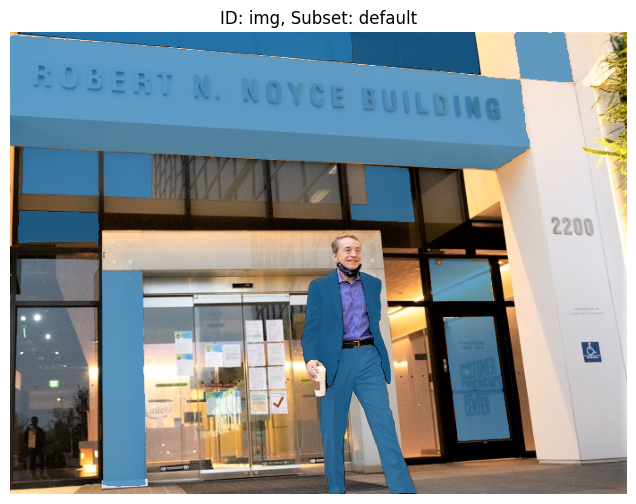Automatic instance mask annotations generation using Segment Anything Model#
This tutorial covers how to generate instance maks annotations automatically using Segment Anything Model (SAM). This feature requires a dedicated model inference server instance. We provide how to build the Docker image of model inference server for SAM in this guide. Please build the Docker image first before you follow this tutorial. We
will use the vit_b SAM model deployed on OpenVINO™ Model Server instance, thus you need to build segment-anything-ovms:vit_b Docker image in preperation. However, the other SAM model types (vit_l and vit_h) are avaialbe as well.
Prerequisite#
Download a sample image#
Before starting this tutorial, please download the following sample image. We will generate instance mask annotations for this image.
curl -O https://raw.githubusercontent.com/openvinotoolkit/datumaro/develop/docker/segment-anything/images/intel_rnb.jpg
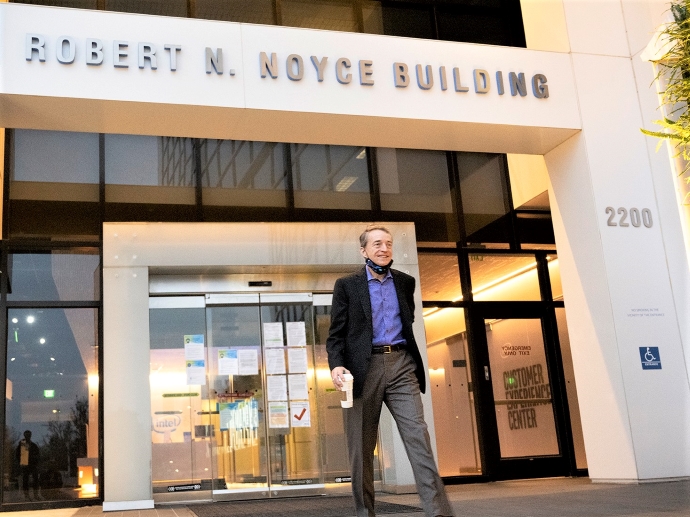
Launch the Model Inference Server for SAM#
In this tutorial, we will launch an instance of the OpenVINO™ Model Server to serve the SAM encoder and decoder models on your local machine. Alternatively, you can opt for the NVIDIA Triton™ Inference Server as well. For additional information, please refer to this guide.
To launch the OpenVINO™ Model Server instance and expose the gRPC endpoint on localhost:8001, use the following docker run command:
[ ]:
!docker run -d --rm --name ovms_sam -p 8001:8001 segment-anything-ovms:vit_b --port 8001
Transfrom bounding box to instance mask annotations#
We first create a dataset from the sample image you download. You can see that there is one dataset item in the dataset, which has an id as img.
[3]:
# Copyright (C) 2023 Intel Corporation
#
# SPDX-License-Identifier: MIT
import datumaro as dm
item_id = "img"
items = [
dm.DatasetItem(
id=item_id,
media=dm.Image.from_file("intel_rnb.jpg"),
annotations=[],
)
]
dataset = dm.Dataset.from_iterable(items)
dataset
[3]:
Dataset
size=1
source_path=None
media_type=<class 'datumaro.components.media.Image'>
annotated_items_count=0
annotations_count=0
subsets
default: # of items=1, # of annotated items=0, # of annotations=0, annotation types=[]
infos
categories
As we can see, there is no annotation in the dataset item.
[4]:
item_id = "img"
subset = dm.DEFAULT_SUBSET_NAME
viz = dm.Visualizer(dataset, figsize=(8, 6))
fig = viz.vis_one_sample(item_id, subset)
fig.show()
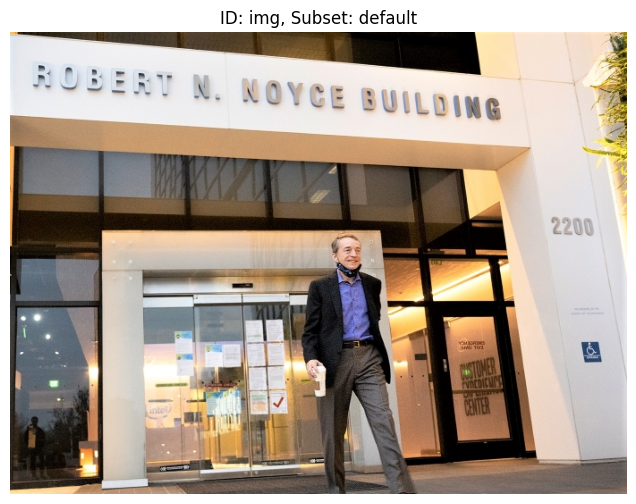
Now, we apply SAMAutomaticMaskGeneration to the dataset. This transform requires several arguments to execute properly.
inference_server_type represents the type of inference server on which SAM encoder and decoder are deployed. In this example, we launched the OpenVINO™ Model Server instance. Therefore, please select InferenceServerType.ovms.
The gRPC endpoint address was localhost:8001. To configure this, provide the following parameters:
host="localhost"port=8001protocol_type=ProtocolType.grpc
You can also specify a timeout=60.0 value, which represents the maximum seconds to wait for a response from the server instance.
Lastly, we’ve set num_workers=0. This means we will use synchronous iteration to send a model inference request to the server instance and wait for the inference results. If you need to handle multiple inference requests concurrently, you can increase this value to utilize a thread pool. This is particularly useful when dealing with server instances that have high throughput.
[8]:
from datumaro.plugins.sam_transforms import SAMAutomaticMaskGeneration
from datumaro.plugins.inference_server_plugin import InferenceServerType, ProtocolType
with dm.eager_mode():
dataset.transform(
SAMAutomaticMaskGeneration,
inference_server_type=InferenceServerType.ovms,
host="localhost",
port=8001,
timeout=60.0,
protocol_type=ProtocolType.grpc,
num_workers=0,
points_per_side=16,
)
Let’s visualize the transformed dataset again. In the following figure, you can see that many instance mask annotations are generated.
[9]:
viz = dm.Visualizer(dataset, figsize=(8, 6), alpha=0.7)
fig = viz.vis_one_sample(item_id, subset)
fig.show()
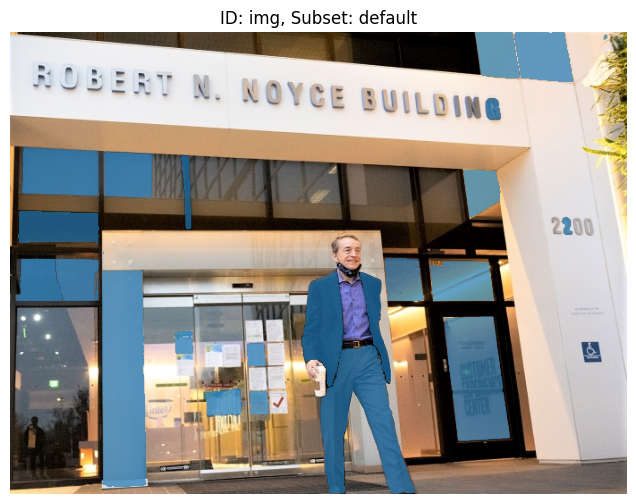
Let’s explore some important parameters used in this feature.
This transformation includes a post-processing step designed to enhance the quality of the generated instance masks. You have the flexibility to adjust several parameters for this post-processing step:
points_per_side(int): The number of points to be sampled along one side of the image. The total number of points is points_per_side**2 on a uniform 2d grid.points_per_batch(int): Sets the number of points run simultaneously by the model. Higher numbers may be faster but use more GPU memory.pred_iou_thresh(float): A filtering threshold in [0,1], using the model’s predicted mask quality.stability_score_thresh(float): A filtering threshold in [0,1], using the stability of the mask under changes to the cutoff used to binarize the model’s mask predictions.stability_score_offset(float): The amount to shift the cutoff when calculated the stability score.box_nms_thresh(float): The box IoU cutoff used by non-maximal suppression to filter duplicate masks.min_mask_region_area(int): If >0, postprocessing will be applied to remove the binary mask which has the number of 1s less than min_mask_region_area.
This time we increase the points_per_side value to create instance masks more densely.
[11]:
with dm.eager_mode():
dataset.transform(
SAMAutomaticMaskGeneration,
inference_server_type=InferenceServerType.ovms,
host="localhost",
port=8001,
timeout=60.0,
protocol_type=ProtocolType.grpc,
num_workers=0,
points_per_side=32,
)
viz = dm.Visualizer(dataset, figsize=(8, 6), alpha=0.7)
fig = viz.vis_one_sample(item_id, subset)
fig.show()
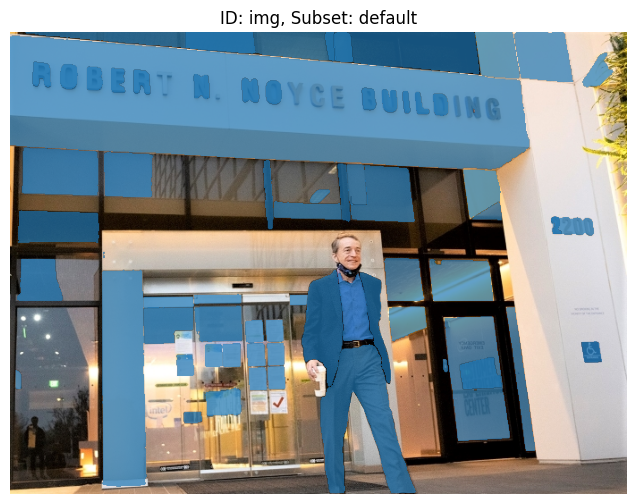
To produce masks only for the large enough instances, we can set the min_mask_region_area value to 2500 as follows.
[14]:
with dm.eager_mode():
dataset.transform(
SAMAutomaticMaskGeneration,
inference_server_type=InferenceServerType.ovms,
host="localhost",
port=8001,
timeout=60.0,
protocol_type=ProtocolType.grpc,
num_workers=0,
points_per_side=32,
min_mask_region_area=2500,
)
viz = dm.Visualizer(dataset, figsize=(8, 6), alpha=0.7)
fig = viz.vis_one_sample(item_id, subset)
fig.show()
